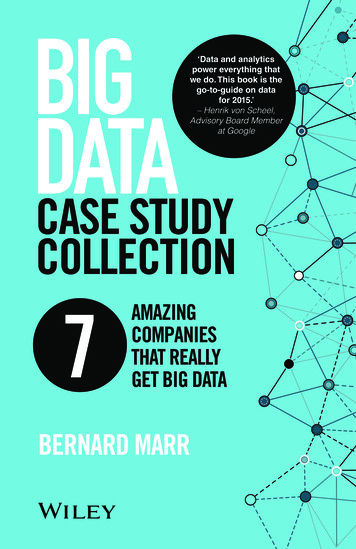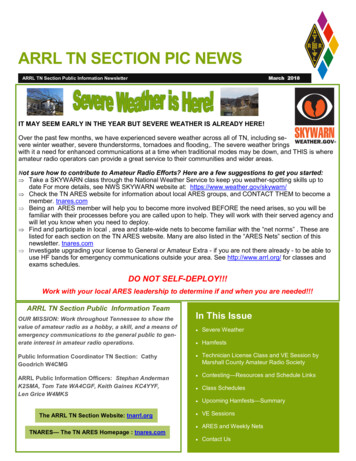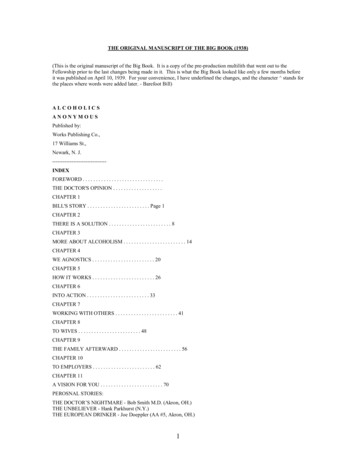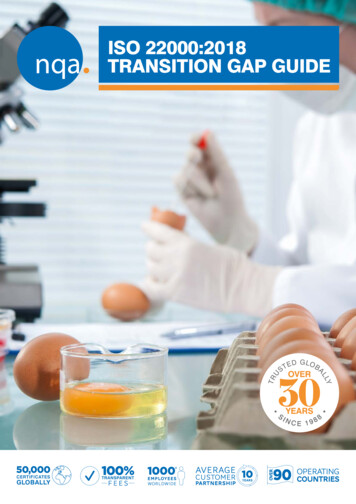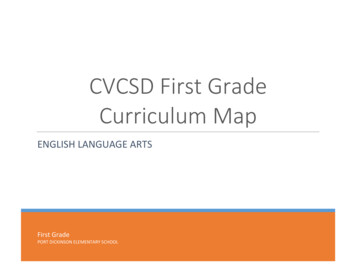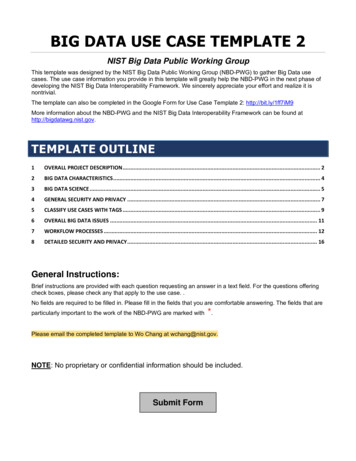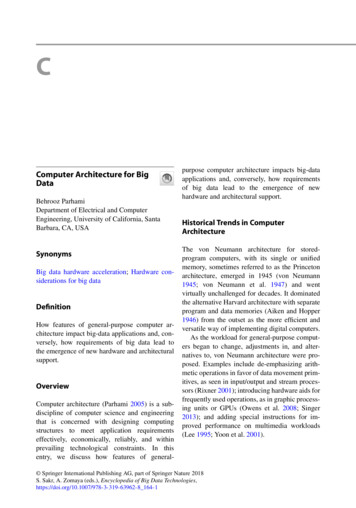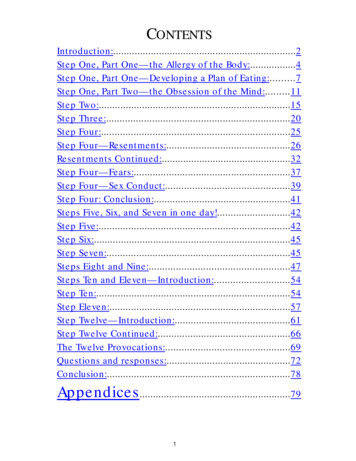
Transcription
CONTENTSIntroduction:.2Step One, Part One—the Allergy of the Body:.4Step One, Part One—Developing a Plan of Eating:.7Step One, Part Two—the Obsession of the Mind:.11Step Two:.15Step Three:.20Step Four:.25Step Four—Resentments:.26Resentments Continued:.32Step Four—Fears:.37Step Four—Sex Conduct:.39Step Four: Conclusion:.41Steps Five, Six, and Seven in one day!.42Step Five:.42Step Six:.45Step Seven:.45Steps Eight and Nine:.47Steps Ten and Eleven—Introduction:.54Step Ten:.54Step Eleven:.57Step Twelve—Introduction:.61Step Twelve Continued:.66The Twelve Provocations:.69Questions and responses:.72Conclusion:.78Appendices.791
Introduction:The Big BookThe following is an adaptation of a Step Study I didonline in the summer and early fall of 2005.I’ve been in OA since February 11, 1986. I startedworking the steps and lost weight, then relapsed,then lost weight, then relapsed.OA stands for the proposition that the Twelve Stepsgive us freedom from the bondage of food. If thesteps aren’t working for you, then maybe you’re notworking the steps in a way that works for you. Itmight therefore be worth it to try the approach to thesteps used in this step study, based on the Big Book.Finally someone in the rooms confronted me (I’ll talkmore about that in Step 12) and I discovered a method of working the steps that has worked for me. Ibecame abstinent, worked the steps, and achievedthe miracle of being freed from the foods that usedto beckon to me, being able to be around them,without wanting them. That has been true for mesince about May 1, 1993.The Big Book was written as a set of directions fordoing the steps. It was aimed at those people whowould not be able to meet anyone from AA, becauseat the time it was published AA was centered in NewYork City, and Akron and Cleveland, Ohio. So the BigBook was written as a do-it-yourself manual. As suchit is a textbook––a book which contains valuableinformation to compulsive eaters.It took me about a year, as I look back, to achieve ahealthy body weight, and I’ve maintained that bodyweight since that time. In March, 2005, I began tolose more weight for reasons I’ll talk about later.It’s not a perfect book, that’s for sure. It was writtenby Christian male alcoholics who had found themselves in the gutter and had done a lot of harm toother people. It needs to be interpreted and appliedfor people who did not have their exact same experience, and it sometimes needs to be clarified becauseof its 1930s language. But besides its being a greatinspirational and loving book, it is one of the greatesttextbooks ever written, and I hope you’ll join me inthe study of its directions!This Step StudyThose of you familiar with the well-known AA team ofJoe and Charlie will recognize much of what I sayhere, although I base this study on my own experience, of course.The basic outline of the Big Book’s discussion of theSteps is as follows:Virtually all of this step study is based on what I havelearned from the great AA speakers, Joe and Charlie,Roger, and Blaine D. from Winnipeg, Canada, and alot of reading of AA history and experience. I don’tthink much of what I have to say is particularlyoriginal. I therefore want to acknowledge the teachings of AA and of those who have given their time andeffort and experience to convey the message ofrecovery to those who still suffer.To help you in this Step Study, it would be useful for youto download certain documents and forms, including StepFour forms, used in weekend Big Book Studies done formany OA intergroups. They’re also reproduced in thisstudy.You’re welcome to download them and distribute themhowever you want. The Step Four forms and the StepEleven form were drawn up by an AA Big Book thumper inWinnipeg, Canada, named Blaine, and OA owes him a debtof gratitude for allowing these forms to be used. They’vebeen used by thousands of people with great success! Theforms have been slightly modified from Blaine’s originalswith his permission. Howard W. of Minneapolis has reformatted the Step 4 and Steps 8 & 9 forms to allow them tobe filled in on your computer using a PDF reader likeAdobe or PDF-Xchange.Copyright 2006-2018 by Joseph Securities Ltd. Copyright has been transferredto a corporation for the sake of anonymity.This version is dated Friday, February 8, 2019.Because this represents a merging of the teachings of many BigBook thumpers, including the AA speakers Charlie, the twoJoes, Blaine, and Roger, it’s not original. I’ve simply put together the thoughts of others from an Overeaters Anonymousperspective. The text is copyrighted only to make certain thatit remains unchanged––not to prevent its use.Included among the documents is also a Step Four Outline, which summarizes a lot of the concepts you’ll finddiscussed in this study.Therefore reproduction of this book is permitted if the text and thisnote remain unchanged and copies are sold at cost (fund-raising byOA Groups alone is acceptable); as well, “OA” or “OvereatersAnonymous” or the name of the author should not appear on anytitle page. As well, the title given should reflect that it is a personalinterpretation of the Big Book’s directions for compulsive eaters.This is a work constantly in progress. Criticisms, suggestions,disagreements, comments are very welcome. Contact theauthor by going to www.oaabigbook.info, clicking on the topimage, and then clicking on “here” in the sentence: “Comments? Questions? You can send an e-mail here.”Go towww.oabigbook.infoto download all the forms and get the latest version ofthis Step Study. This book contains many of those formsas well.2
·Step One: “The Doctor’s Opinion”, part ofChapter One, “Bill’s Story”, most of ChapterTwo, “There Is A Solution”, and ChapterThree, “More About Alcoholism”.·Step Two: part of Chapter One, “Bill’sStory”, part of Chapter Two, “There Is ASolution”, Chapter Four, “We Agnostics”.·Step Three: part of Chapter Five, “How ItWorks”.·Step Four: part of Chapter Five, “How ItWorks”.·Steps Five, Six, Seven, Eight, Nine, Ten, andEleven: Chapter Six, “Into Action”.·Step Twelve: Chapter Seven, “WorkingWith Others”, and part of Chapter Eleven,“A Vision For You”. Chapters Eight,”To TheWives”, Nine, “The Family Afterward”, andTen, “To Employers”, can also be read ascontaining discussions of Step Twelve, butI won’t be dealing with them in any greatdetail.The Twelve ProvocationsAs I’ve been taught, the Big Book stands for thefollowing concepts. Each one of them is controversial in some OA groups. They are simplyintended to create some interest in what follows. They are not intended to be offensive,however.1. I am a recovered compulsive eater, not arecovering one.2. Abstinence is not the most important thingin my life without exception; the consciousness of the presence of God is.3. Although a sponsor, if available, is veryimportant for recovery, a sponsor is not necessary to recover.4. You can recover in weeks.5. The Tools of Recovery are not an essentialpart of the OA program.A much more detailed outline of the Big Book isfound in A Schematic Outline of the Big Book as foundat www.oabigbook.info or in the Appendix to thisbook.6. You don’t take Steps One and Two.7. Steps Three, Six, Seven, and Eight, shouldnot take a long time to get throughQuestions8. You don’t make amends to yourself.The questions at the end of each chapter in this BigBook Study were part of the format of the originalonline Step Study on which this book is based.9. You cannot carry the message until after youhave completed Step Nine.I hope they’re useful questions. They are notintended, however, to be substitutes for actuallydoing the steps. Doing the steps is what the rest ofthis step study is all about!10. Service is not slimming.11. Food can be discussed at meetings.12. Every person who wants to be a member ofOA should know exactly what having “a desireto stop eating compulsively” means.These “provocations” are explained fully, beginning at page 69.Why use the Big Book directions?If the way you work the steps has givenyou the recovery described by the BigBook, then why would you switch?If, however, you are not free from thebondage of food, if food at times becomesattractive to you, if you’re really whiteknuckling it, then why not try the Big Bookdirections? They’re guaranteed!3
My Problem:Step One, Part One—theAllergy of the Body:The Physical Allergy:An allergy is an abnormal physical reaction to something. In my case, it’s mybinge foods and my binge eating behaviors. Once I start eating my binge foodor indulging in my binge eating behaviors, I find it almost impossible to stopeating it.The Big Book’s approach to Step One is what Dr.William Silkworth, the doctor who wrote the twoletters found in The Doctor’s Opinion, called “thedouble whammy”.Put simply, we have (1) an abnormality of the body (hecalled it an “allergy of the body”) which means thatonce we start eating certain kinds of foods orindulging in certain compulsive eating behaviors wedevelop cravings which overpower us; and we have(2) an abnormality of the mind (he called it a “mentalobsession”) which means that even if we stop eatingthose foods or indulging in those behaviors, ourmind persuades us that we can return to eatingthose foods and indulging in those behaviors.The Mental Obsession:An obsession is an idea which takescontrol over all other ideas. In my case,if I’ve stopped eating my binge foods orindulging in my binge eating behaviors,my mental obsession gives me reasonsto go back to eat the binge foods orindulge in my binge eating behaviors.Thus we can’t stop once we start (the allergy thatcreates cravings), and we can’t stop from startingagain (the obsession that sends us back). We arethus in a vicious circle. That is the explanation foryo-yo dieting, and for all the despair that we bringto OA when we join.My problem in a nutshell––the addict’s dilemma:It’s often said that alcoholics can stop drinking butOAers can’t stop eating. From the Big Bookperspective, that isn’t correct. Alcoholics have todrink, but they can’t drink alcohol. OAers have toeat, but they can’t eat the foods or indulge in theeating behaviors that create the cravings.I can’t stop once I’ve started. And Ican’t stop from starting again.In this statement he confirms what wehave suffered alcoholic torture MUSTbelieve—that the body of the alcoholic isquite as abnormal as his mind. In ourbelief, any picture of the alcoholic whichleaves out this physical factor isINCOMPLETE.The main difference between the member of AA andthe member of OA is that everyone in AA knows thatalcohol is the ingredient that AAers can’t drink,whereas in OA different people may have differentfoods they can’t eat and different eating behaviorsthey can’t indulge in. Part of the job of Step One isfor each individual to figure that out for him- orherself.On pages xxviii to xxix of the 4th edition (xxvi toxxvii 3rd edition), Dr. Silkworth talks about theallergy:Please read The Doctor’s Opinion. It’s found justbefore page one in the book, although differenteditions have different page numbers. I ask youspecifically to note the following.The action of alcohol on these chronicalcoholics is a manifestation [symptom]of an allergy; [and the allergy is a]phenomenon of craving [which] islimited to this class and never occurs inthe average temperate drinker. Theseallergic types can never safely usealcohol in any form at all. Men andwomen drink essentially because theylike the effect produced by alcohol. Thesensation is so elusive that, while theyadmit it is injurious, they cannot after atime differentiate the true from the false.On page xxvi of the 4th edition (xxiv of the 3rdedition), the writers of the Big Book emphasizewhat they see in Dr. Silkworth’s long letter that isimportant for AA.When I quote from the Big Book and omit somewords, I don’t put in the usual dots like . . .I think it’ll be easier to follow. I also capitalizeimportant words for emphasis.I urge you to read the original; don’t take my wordfor it that I’ve quoted fairly!4
Meanwhile my mind is saying to itself, “I’ve got tostop, I’ve just got to stop. If I eat any more, I’ll burst.If I get any fatter, I’ll have to get new clothes. I’malready too fat. I just have to stop! Why can’t Istop? I’m at risk for diabetes and heart attack andhigh blood pressure. I just have to stop!”To them their alcoholic life seems theonly normal one. They are restless,irritable and discontented, unless theycan again experience the sense of easeand comfort which comes at once bytaking a few drinks, [which thendevelops] the phenomenon of craving.And the hand keeps bringing more food to mymouth.On page xxx in the 4th edition (xxviii 3rd edition),Dr. Silkworth describes a spectrum of alcoholictypes, ranging from the psychopath through to themanic depressive through to a person perfectlynormal in all other respects. He says that their only“symptom in common [is that] they cannot startdrinking without developing the phenomenon ofcraving.”Does that ring a bell? You want so desperately tostop but you can’t. I did have all the reasons in theworld to stop but I couldn’t. The hand kept movinguntil there was nothing left.Second example:This one involves a goose skin.I’m Jewish (but an agnostic, which I’ll talk aboutwhen we get to Step Two), and one of our greatcelebration holidays is Chanukah, the Festival ofLights, which is held around Christmas-time. Itcould easily be called the Festival of Grease, becausethe food we traditionally ate on Chanukah was verygreasy.The phenomenon of craving:What is this phenomenon of craving?A phenomenon is an unexplained occurrence. It issomething that happens for which we don’t have aclear explanation. We can describe it. We just don’tknow why it happens.My mother had cooked a goose, as well as deepfried pancakes over which we put the goose gravy.(Not that there really is goose gravy; it’s just the fatof the goose that has dripped into the pan.) I don’tremember the dessert we had, but I’m sure it wasextremely rich. I was loaded to the gills after themeal—just packed. The ten or fifteen people whowere at the dinner went into the living room, justaround the corner from the kitchen.The phenomenon of craving is a craving that can’tbe explained. It just happens. There may be biological reasons for the craving, and we know thatthere’s a lot of research on why some peoplebecome binge-eaters. But the concept of thephenomenon of craving puts the emphasis not onexplaining it, but on making it obvious and powerful.What “the phenomenon of craving” describes is anoverpowering urge for more and more.I went to the kitchen to get a diet drink (I’ve alwaysloved that!) and I saw the goose carcass on thecutting board with the goose skin hanging on thecarcass. A goose is so fat that the skin just slips off.I can talk about myself in this connection. And thebest way is simply to tell those parts of my story thatillustrate the phenomenon of craving. In that wayyou can discover similarities. There will be differences—the foods and eating behaviors that causemy cravings may not be the ones that cause yours.But if you’re a member, or a prospective member, ofOA, I’ll bet you’ve had the same symptoms!Even though I was completely stuffed, I rememberthinking to myself, “Well, I can’t eat a lot, but I lovethe taste of goose skin, and we don’t have it thatoften, so I’ll just take a bite.”So I picked up the entire skin and took a small bitefrom it. It was still very hot from the oven. But theskin is very tough and I couldn’t just take off a bit,so I put a bit more into my mouth to find a weakspot.First example:This is really virtually all my stories.My hand has food; maybe my hand is holding a forkor a spoon with food, or maybe it’s just holding thefood itself. The food could be buttered popcorn orpotato chips or ice cream or french fries. My handis coming to my mouth and putting the food in mymouth, and going back and getting more food andputting more food in my mouth, and that just keepson going.I blank out a bit here, but I remember suddenlyrealizing that I had the entire goose skin in mymouth and was chewing it frantically, because it wasburning the inside of my mouth. Fat was spurtingout between my lips. My cheeks were bulging. Ikept on chewing until all the fat was gone from theskin, and then I swallowed the skin whole.5
once he starts to drink” (page 21). This is the allergyof the body—the lack of control once the substanceis taken into the body—the phenomenon of craving.Third example:This one involves a greasy spoon in Minneapolis,sometime in probably March 1962 or 1963. It wasabout 6 in the morning. I had just come off anovernight train ride and had a two-hour wait for abus to go to my college south of Minneapolis. Istarted to wander down Hennepin Avenue, whichwas pretty grimy in those days.Notice how different this is from the conventionaland perhaps medical definition of an addict, wherequantity–overindulgence–is the defining characteristic. The Big Book clearly says that quantity is notthe defining characteristic. The defining characteristic, it says, is at the very least the inability to stoponce the indulgence begins. Compulsive overeatersor alcoholics might be able to limit their number ofbinges or even the quantities they consume.I passed a greasy spoon that advertised a 39 centbreakfast with sausages and bacon, so I went in. Itwas packed with people who had clearly been up allnight, hacking and coughing. I squeezed onto astool at the counter and got my greasy meal andstarted to eat it.The real question is whether they get the phenomenon of craving once they start.This explains why some diets and some dietprograms work for others, but not for people likeus. They are not compulsive eaters—at least theway the Big Book defines it. Diets “give back” bingefoods in moderation after the weight is lost. Manypeople can eat those binge foods in moderation.But we can’t–we get the phenomenon of craving.Suddenly the man on my right vomited into hisplate, and then fainted, and his head dropped rightinto the plate.Here is the question which might separate acompulsive eater from a normal eater: What woulda normal eater do and what did I do?There is another aspect That is the mental obsession, and the Big Book spends a lot of timediscussing the mental obsession. But now thatwe’ve discussed the phenomenon of craving, it’stime to abstain from those foods and eating behaviors that cause our craving.Yes, I turned my back on the man and continued toeat.Summary:It is perfectly obvious that I react very differentlythan normal eaters.Questions:I can’t stop once I’ve started. Normal eaters stopwhen they’re full; normal eaters stop eating whensomething happens that’s nauseating; even whennormal eaters overeat, the next day they don’t eat alot. At one point or another they get unease ordiscomfort when they overeat, and their body basically tells them to stop.Here are some questions:I get that feeling with alcohol. I can’t drink morethan a glass and half of wine or beer (I don’t likeliquor) before I get this feeling of having hadenough. I don’t like that feeling, so I stop. Alcoholics don’t feel that way when they drink. And Idon’t feel that way when I overeat.The Big Book begins to define the alcoholic towhom it is addressed in Chapter Two, There is aSolution, on pages 20 to 24.There the Big Book discusses the moderate and thehard drinkers, both of whom can give up alcohol ifthere is a good reason, and contrasts them with thereal alcoholic. The real alcoholic is different. Thereal alcoholic can be either a moderate or a harddrinker, “but at some stage of his drinking career hebegins to lose all control of his liquor consumption,6·What are my stories of overeating? Do Ihave the equivalent of a gallon of icecream, or a goose skin, a huge bag ofpotato chips, the whole container ofcookies, or eating at times or in ways thatnormal people wouldn’t eat?·Have I experienced times when no matterhow great my desire, I couldn’t stop eating?·Are there certain foods that once I starteating, I find it almost impossible to stopeating, until there’s no more?·Are there certain foods that I can’t imagineever giving up for good?·Are there any patterns in my overeating?Are there certain times of the day, orcertain kinds of situations, in which I findthat I can’t stop eating?
Step One, Part One—Developing a Plan of Eating:cravings. I can put some jam on my toast and don’tget cravings, but I know people in this program whocan’t touch it at all.In the last chapter I described the phenomenon ofcraving—what Dr. Silkworth describes in the BigBook as an “allergy” of the body. This is the firstpart of Step One.In my discussions with other OAers from all over theworld, I’ve come to the conclusion that, althoughthere’s an awful lot of overlap in our binge foods, inthe rooms of OA there are people who can eateverything that I can’t eat, and that I can eat everything that some people in OA can’t eat at all. TheDignity of Choice makes this very clear—our plan ofeating is an individual plan.Allergy doesn’t mean a cough or a runny noise or arash; it means simply an abnormal physical reactionto a physical substance. The allergy of the body weget when we overeat is the “phenomenon ofcraving”. A phenomenon is an occurrence for whichthere is no explanation. We get cravings that wecan’t explain. But the essence of the cravings is thatwe simply cannot stop. Our body is telling us to eat,and we can’t stop eating, just as we can’t stopbreathing or blinking our eyes––we may be able tosuspend our breathing or blinking temporarily, butwe simply can’t stop.So how do we identify what causes our cravings? Ican only tell you what I have done, and what peopleI’ve discussed this with have done. You have tofigure it for yourself.1. Abstain from individual bingefoods.I started by asking myself a simple question: Whatare the foods that I consistently overeat when I havethe chance to eat them? What are the foods that Ihunch over, hoarding, eating incessantly, blissingout?The topic of this chapter comes from Dr. Silkworthin The Doctor’s Opinion. He says: “Of course analcoholic ought to be freed from his physical cravingfor liquor”. The Big Book takes sobriety for granted.No one attends AA thinking that he or she is goingto continue drinking while working the steps. Youstop drinking. You do anything to stop drinking,even if it means going to three or four meetings aday. And you work the steps.The answers were clear for me: buttered popcorn,potato chips, shortbread, cheesecake, ice cream,deep-fried foods in general but in particular friedchicken (especially the skin), fatty meats (beef ribsand pork ribs and sausages and bacon), doughnuts—and many other similar kinds of foods.What about us in OA? Is that OA’s message—thatwe stop compulsive eating, do anything to stopeating compulsively (even if means going to as manymeetings as we can, and phoning as many people aswe can, and reading as much literature as we can),and work the steps? It should be.Clearly any food that I couldn’t stop eating when Istarted was a food that caused cravings. I had toeliminate those.2. Abstain from individual bingeingredients.We have to stop our craving, and the only way tostop the craving is to stop eating foods that causeour craving. (We also have to stop the eating behaviors that cause our cravings, and I discuss thatbelow.) Our Dignity of Choice pamphlet makes thatperfectly clear.But I went further than that. I asked myself whetherthere was a common ingredient in those foods, andif so, whether the presence of that common ingredient seemed to be a problem for me in general.So how do we go about it? Sure, it’s easier for analcoholic to identify the substance that causes theallergy. For the alcoholic, it’s alcohol in any form—whether in beer or wine or liquor or liqueur. But forthe compulsive eater, Dignity of Choice says, and myexperience confirms, that we can all differ in thekinds of substances that cause cravings for us.The answer was obvious—fat. I seemed to overeatalmost anything that was high in fat content. It wasusually fat mixed with salt or fat mixed with sugar.All fats had such a huge effect on me, but I realizedas well that high-fat dairy products, like butter,were especially powerful for me.Was sugar a problem for me? Well, I had eliminatedmost sugars from my eating—other than those withhigh fat content—years before I began to analyzemy cravings. I just didn’t eat foods that were sweetFor example, I can’t eat butter in any form before Istart craving it. But I know people in this programwho can eat a pat or two of butter and don’t get7
I had a blinding flash of the obvious as I sat in mydentist’s chair having my third or fourth or fifthcrown put onto teeth that I had worn down orbroken by chewing on bones and other things. Mybiggest eating behavior was simply chewing,keeping my mouth busy, constantly seeking oralgratification!but not fat, like pop or some kinds of desserts. Verysweet foods actually gave me a headache. So Ididn’t include sugar in my list. Fat was clearly theculprit for me.I therefore developed a plan of eating that eliminated foods with high fat content, and eliminated allhigh-fat dairy products in particular. I would nothave a meal with a fat content higher than 10% ofcalories through fat. That meant I would have nodeep-fried foods at all, and no snacks that containeda significant amount of fat (all potato chips, whetherbaked or not). I would examine content labelscarefully for hidden fat content.I realized that while I had adopted a plan of eatingthat eliminated high fats, I was constantly chewing.Where I used to chew buttered popcorn, I was nowchewing carrots and celery and gum and hot-airpopcorn. I was keeping my mouth busy—just as apopular weight-loss program used to tell me wasnecessary in order to keep from eating other foods.If given a choice between a food that had no fat andone that had even a little fat, I would choose thenon-fat one (1% versus skim milk; spaghetti sauceswith a little olive oil versus with no oil). I would trimall visible fats away from meat. I would not eat fattymeats. I would not eat any desserts and would havefruits instead.What I discovered in my analysis was that myconstant chewing kept my mouth wanting to chewmore. At my mealtimes I was eating for the sake ofchewing. Sure, it wasn’t high fat foods, but it wasfood that contained calories of some sort. I wastaking in too much food.I remembered the time years before when I firstjoined OA and my plan of eating was so simple—three meals a day, nothing in between, a day at atime. I lost a lot of weight on that plan.I did that. It was hard work, but I did it. I alsoworked the steps, and just as promised at Step 9 inthe Big Book, I was freed from my wish to eat all thefoods that I had eliminated. I had recovered fromcompulsive eating! I could be around ice cream andnot want it. That was a miracle. I was freed fromthe obsession. (I’ll talk more about the obsessionnext chapter. It’s the second part of Step One.)This was before I discovered the notion of theallergy of the body, so as soon as I lost that weightI took back a lot of foods I had eliminated, like icecream and buttered popcorn and deep-fried foods,convinced at that time that my only problem wasquantities. That is, of course, what almost all dietstell us. They tell us that once we lose the weight,we can eat everything—so long as we eat in moderation! But what’s moderation to me once my allergykicks in? It’s impossible! Once I started eating icecream, I couldn’t stop!But after a number of months I hadn’t lost muchweight. I was clearly taking in too much food, eventhough it was much healthier food than it wasbefore.I discussed this with my sponsor. I felt that StepTwelve required me to carry the message ofrecovery through the Twelve Steps. How could Icarry that message if I wasn’t at a healthy bodyweight? I felt I couldn’t—I felt that I was missingsomething.One element of 3-0-1 clearly did work for me—andthat was not eating between meals. That did something for me, I began to realize, that I wasn’t doingthis time. Eliminating any chewing or suckingbetween meals kept me from craving that oral gratification I used to get.3. Abstain from individual bingeeating behaviors.So I added another element to my plan of eating. Inaddition to eliminating all foods high in fat content,I stopped eating between meals.Around this time I reread the OA Twelve andTwelve. On pages two and three the book mentionsnot simply binge foods but also “eating behaviors”.This was difficult for me. I found myself chewing icein my drinks, chewing or sucking on the ends of mypens, playing with my toothpick. But eventually Iw
The Big Book OA stands for the proposition that the Twelve Steps give us freedom from the bondage of food. If the steps aren’t working for you, then maybe you’re not working the steps in a way that works for you. It might therefore be worth it to try the approach to the steps used in

